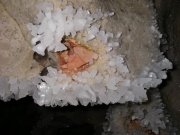Calcite (Inventory)/Spar/nailhead
From LagWiki
| Line 4: | Line 4: | ||
Nailhead spar typically is "flatter" or more "cubic" than [[Dogtooth Spar (Inventory)|dogtooth spar]]. The shape is a [[rhombohedron]] where each facet is a rhombus. Except for the shape of each crystal (which is really just one of the two primary crystaline shapes of calcite) it has characteristics very similar to dogtooth spar and can be found in similar locations. | Nailhead spar typically is "flatter" or more "cubic" than [[Dogtooth Spar (Inventory)|dogtooth spar]]. The shape is a [[rhombohedron]] where each facet is a rhombus. Except for the shape of each crystal (which is really just one of the two primary crystaline shapes of calcite) it has characteristics very similar to dogtooth spar and can be found in similar locations. | ||
| - | They can occur singularly; but are usually found in clusters. They can be found lining the insides of | + | They can occur singularly; but are usually found in clusters. They can be found lining the insides of [[vug]]s or cavities and cracks but can also occur on the ceiling or walls directly. They formed when the cave was phreatic and can be obscured by other formations such as flowstone, popcorn, crusts or staining. When looking for nailhead spar, take the time to look into cracks and vugs in the walls, floor and ceiling. And don't forget to examine breakdown -- it may possess a vug containing nailhead spar. |
==See also== | ==See also== | ||
Revision as of 03:09, 9 April 2011
The nailhead field should be used to list stations which exhibit nailhead spar.
Nailhead spar typically is "flatter" or more "cubic" than dogtooth spar. The shape is a rhombohedron where each facet is a rhombus. Except for the shape of each crystal (which is really just one of the two primary crystaline shapes of calcite) it has characteristics very similar to dogtooth spar and can be found in similar locations.
They can occur singularly; but are usually found in clusters. They can be found lining the insides of vugs or cavities and cracks but can also occur on the ceiling or walls directly. They formed when the cave was phreatic and can be obscured by other formations such as flowstone, popcorn, crusts or staining. When looking for nailhead spar, take the time to look into cracks and vugs in the walls, floor and ceiling. And don't forget to examine breakdown -- it may possess a vug containing nailhead spar.
See also

